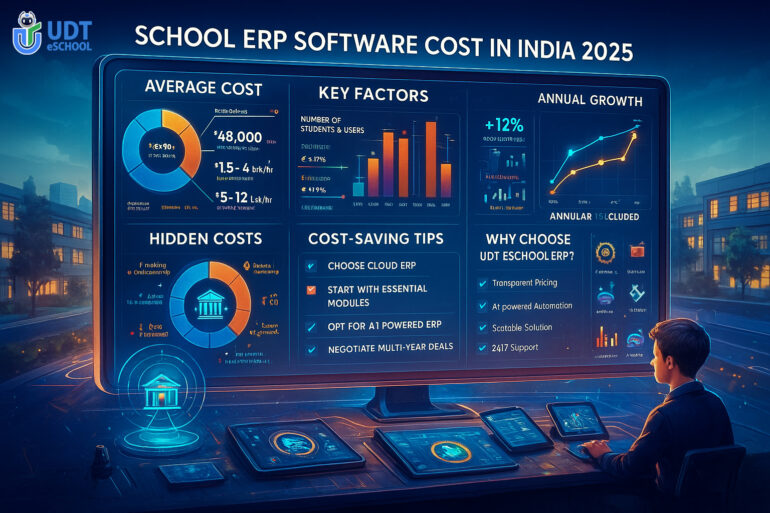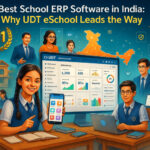School ERP Software Cost in India 2025: Complete Breakdown
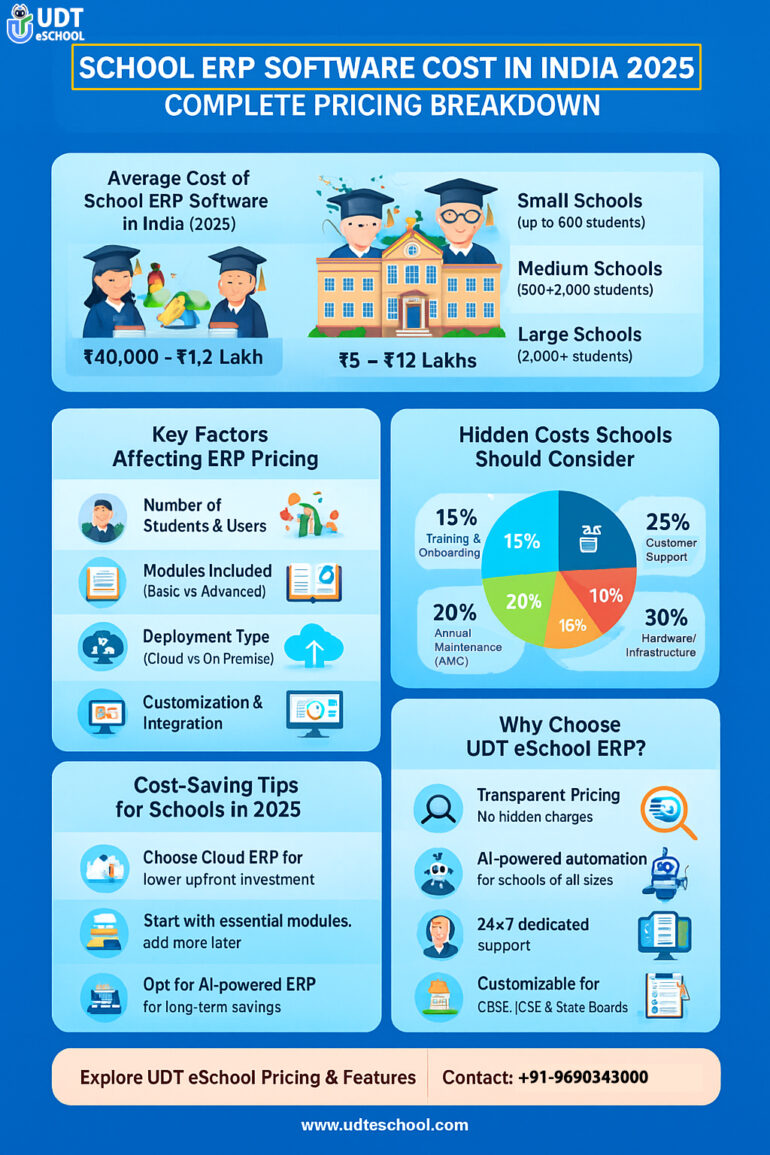
When schools in India think about digital transformation, one of the first questions is: “How much does a School ERP Software cost?”
The answer depends on multiple factors — modules, school size, implementation model, and ongoing maintenance.
In this blog, we’ll give you a transparent breakdown of ERP costs in India (2025), including hidden charges that many vendors don’t tell you upfront.
✅ Average Cost of School ERP Software in India (2025)

-
Small Schools (up to 500 students): ₹40,000 – ₹1,20,000 annually
-
Medium Schools (500–2,000 students): ₹1.5 – ₹4 lakhs annually
-
Large Schools & Institutions (2,000+ students): ₹5 – ₹12 lakhs annually
The pricing varies based on modules, deployment (cloud vs. on-premise), and customization needs.
✅ Key Factors Affecting ERP Pricing
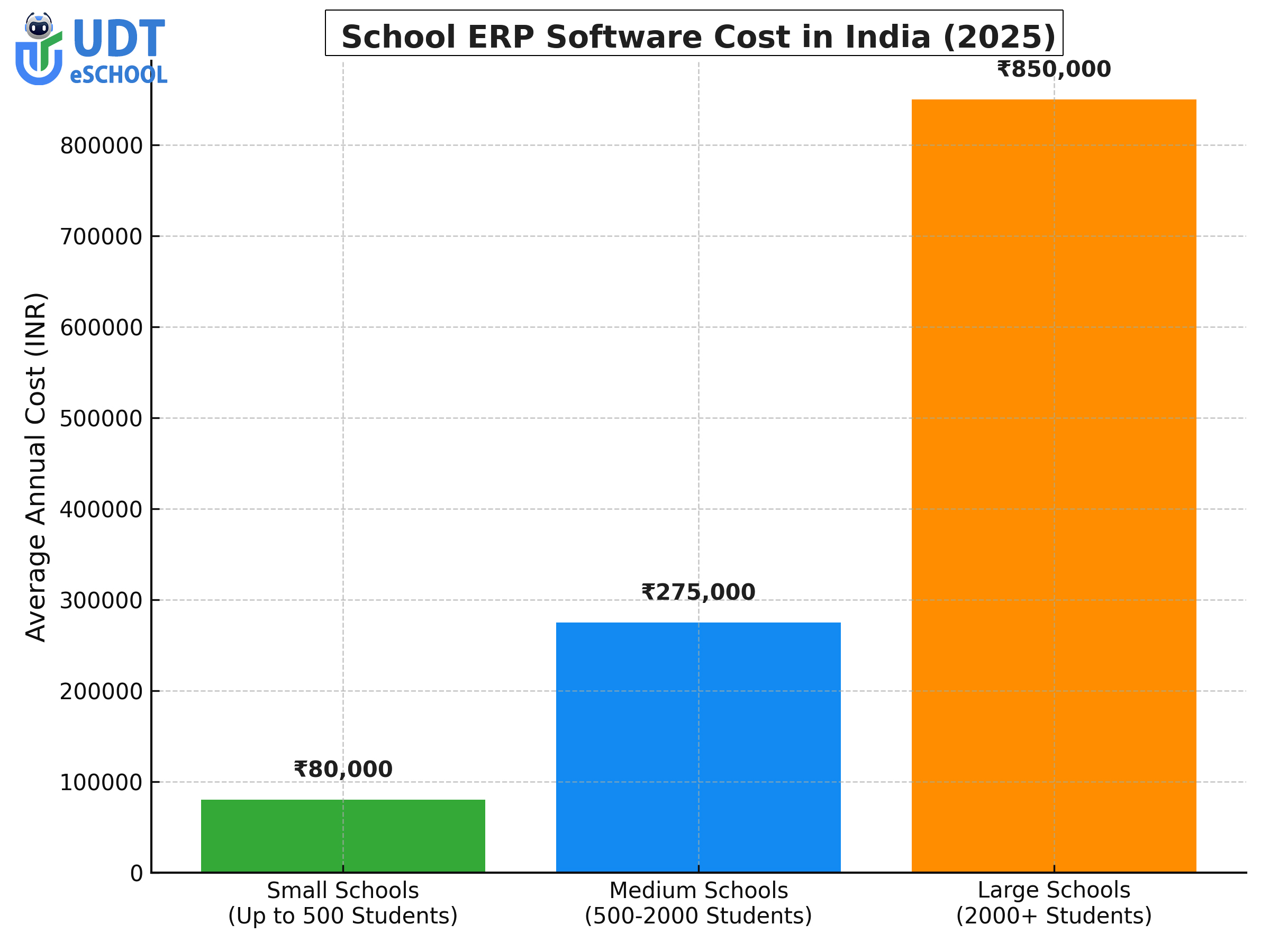
1. Number of Students & Users
Most ERP providers follow a student-based or user-based license model.
-
More students → higher cost.
-
Additional admin/teacher accounts also add to the expense.
2. Modules Included
Basic modules (attendance, timetable, exams) are cheaper.
Advanced modules (AI analytics, fee automation, LMS integration) increase cost.
3. Deployment Type
-
Cloud ERP: Subscription-based, lower upfront cost.
-
On-Premise ERP: One-time license, but higher maintenance.
4. Customization & Integration
Tailor-made solutions for CBSE/ICSE/state boards or integration with third-party apps increase expenses.
✅ Hidden Costs Schools Should Watch Out For
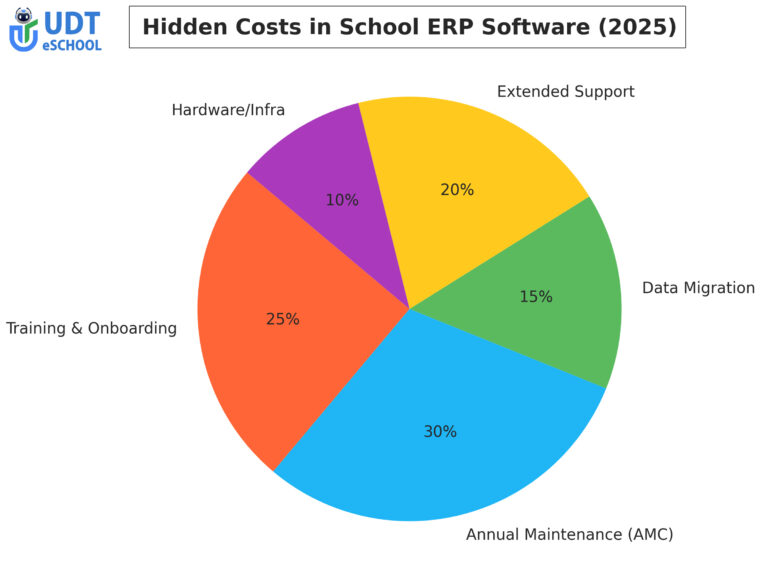
-
Training & Onboarding Fees – Staff training is often charged separately.
-
Hardware & Infrastructure – On-premise models need servers & IT support.
-
Annual Maintenance Contracts (AMC) – Typically 15–20% of license cost per year.
-
Data Migration – Moving legacy records into ERP is billed extra.
-
Support Beyond Working Hours – Some vendors charge for extended support.
Pro Tip: Always ask vendors for a transparent “all-inclusive” cost sheet before signing.
✅ Cost-Saving Tips for Schools in 2025
-
Go for Cloud ERP: Low upfront investment, scalable, and secure.
-
Start with Essential Modules: Add more later as your school grows.
-
Check for AI-Powered ERP: Reduces manual work → lowers long-term costs.
-
Negotiate Multi-Year Deals: Many vendors offer discounts for 3–5 year contracts.
✅ Why Choose UDT eSchool ERP?
-
Transparent pricing, no hidden charges
-
AI-powered automation to reduce admin load
-
Scalable for schools of all sizes
-
24×7 support for teachers & admins
-
Customizable for CBSE, ICSE, and State Boards
Explore UDT eSchool Pricing & Features
❓ Frequently Asked Questions – FAQ

Your top questions about AI-driven ERP, Answered
1. What is the typical cost of school ERP software in India?
The cost varies widely depending on school size, modules, and deployment. For small schools, it can be as low as ₹40,000 – ₹1.2 lakh per year, while large institutions might spend ₹5 lakh to ₹12 lakh or more annually. Hidden costs like training and AMC can increase the total cost.
2. Why do school ERP costs vary so much?
Several factors drive ERP pricing differences, including the number of users/students, the modules included (basic vs. advanced features), whether the system is cloud-based or on-premise, the level of customization needed, and data migration and training services.
3. Are there hidden costs that schools should consider?
Yes—many. Common extra costs include staff training and onboarding, annual maintenance contracts (AMCs), data migration from legacy systems, extended or after-hours support, and infrastructure/hardware costs in on-premise deployments.
4. Is cloud-based ERP more cost-effective than on-premise ERP?
Generally, yes. Cloud-based ERPs reduce upfront infrastructure and maintenance costs, and they scale more easily. On-premise ERPs may involve higher setup and ongoing IT support costs, making them less cost-effective for smaller schools.
5. Can AI-powered ERP systems save schools money?
Absolutely. AI-powered ERPs automate repetitive tasks (such as attendance tracking, fee reminders, and performance analytics), which can significantly reduce administrative workload and errors—leading to long-term cost savings and faster ROI.
6. How can schools save money when buying an ERP?
Some cost-saving strategies include starting with essential modules and adding more later, negotiating multi-year contracts for discounts, choosing cloud-based systems, and opting for vendors with transparent pricing and lower initial training costs.
7. Why should schools ask for a detailed cost breakdown before purchasing ERP?
Requesting a detailed cost breakdown helps schools avoid surprise expenses, compare vendor proposals accurately, and budget appropriately. It also ensures clarity on what services (training, data migration, support) are included and what might incur extra charges.
8. What should schools look for in a good ERP pricing proposal?
Schools should look for transparent, itemized pricing, details about what is included (and what isn’t), clarity on annual maintenance or support costs, training costs, data migration fees, upgrade/upgrade costs, and any long-term or renewal pricing terms.
9. How much does school ERP software cost in India in 2025?
The cost varies by school size and feature set. As a rough guide: small schools (≤500 students) might spend ₹40,000-₹1.2 lakh per year; medium schools ₹1.5-₹4 lakhs; large institutions ₹5-₹12 lakhs annually. Hidden costs (training, maintenance, support) can add another 10-30%.
10. Why isn’t there a single “ERP cost” number for schools?
Because pricing depends on multiple factors: number of students/users, the modules included (basic vs advanced), cloud vs on-premise deployment, customization, integrations, training and support fees.
11. What are the hidden costs schools often underestimate?
Common hidden costs include staff training & onboarding, data migration from legacy systems, annual maintenance contracts (AMC), extended/after-hours support, and — for on-premise or hybrid deployments — hardware and IT infrastructure upgrades.
12. Is cloud-based ERP cheaper than on-premise ERP?
Usually yes, at least for upfront investment. Cloud ERP often works on subscription/seats models, has lower initial capital expenditure, and requires less IT infrastructure. On-premise systems can have lower long-term licensing costs but higher ongoing infrastructure and maintenance expenses.
13. How can a school save money when choosing an ERP?
Some cost-saving strategies include: starting with essential modules and scaling up later, choosing a cloud-based model, selecting an AI-powered ERP to reduce manual work, negotiating multi-year contracts, and asking vendors for transparent all-inclusive pricing.
14. Can UDT eSchool ERP help reduce hidden costs?
Yes — UDT eSchool offers transparent pricing (no surprise add-ons), AI-powered automation to reduce manual workload, scalable plans so schools pay only for what they use, and dedicated 24×7 support to reduce extra support costs.
15. How long does it take to pay off the investment in school ERP software?
It depends on the school’s size, current processes, and how quickly staff adopt the system. In many cases, schools see payback via reduced admin burden, fewer errors, faster fee collections, and better parent/teacher communication within 12–24 months — especially if ERP adoption is paired with proper change management.
16. What should a school ask vendors before signing an ERP contract?
Questions schools should ask include: “What is included in the base cost?”, “Are training and onboarding charged separately?”, “What are annual maintenance or upgrade fees?”, “How many users/students does the pricing cover?”, “What happens if we scale up later?”, and “What is your support policy (hours, response time, extra charges)?”
✅ Call to Action
The future of education is AI-powered and digitally driven. With CBSE reforms around the corner, UDT eSchool ERP ensures schools don’t just adapt but lead the transformation.
Ready to make your school CBSE-compliant and future-ready with AI?
✅ Book a Free Demo of UDT eSchool – India’s 1st AI-Powered School ERP
If you’re looking for the best AI-powered ERP for your school, UDT eSchool is the answer.
✅ Switch to UDT eSchool Today!
The #1 AI-Powered School ERP with Smart Attendance, Predictive Analytics & Full Automation.

